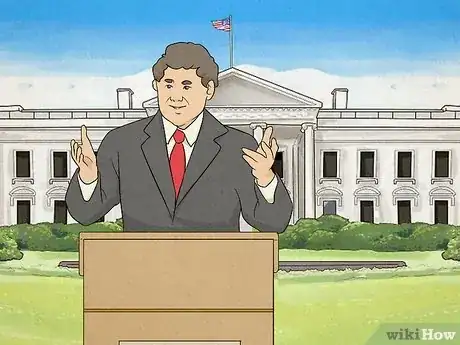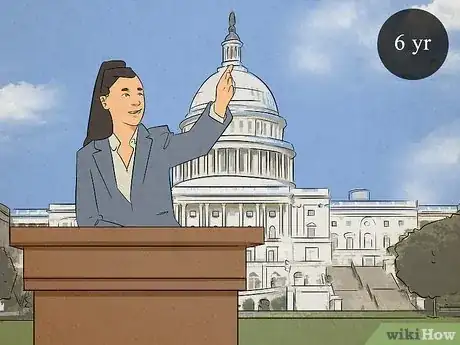This article was co-authored by wikiHow staff writer, Johnathan Fuentes. Johnathan Fuentes is a writer based in the New York City region. His interests as a writer include space exploration, science education, immigration, Latinx cultures, LGBTQ+ issues, and long-form journalism. He is also an avid hiker and has backpacked in Alaska and Newfoundland, Canada. A son of Cuban immigrants, he is bilingual in English and Spanish. Prior to joining wikiHow, he worked in academic publishing and was a freelance writer for science websites. He graduated from Columbia University in 2021, where he studied nonfiction writing and wrote for the student newspaper. He is currently counting down the seconds until the release of Kerbal Space Program 2 in 2023—a game that will almost certainly take up what little free time he has.
There are 11 references cited in this article, which can be found at the bottom of the page.
This article has been viewed 9,110 times.
Learn more...
Studying for a civics test? Or just curious about the difference between senators and governors? Lots of Americans are in the same boat. Though they’re both state-wide positions, governors and U.S. Senators occupy very different roles in American government. We’ve put together a simple breakdown of the differences between governors and senators, plus a few bonus details for those of you who want to dive deeper. Keep reading to become a more informed citizen—or ace that test.
Things You Should Know
- A governor is the leader of a state government’s executive branch, while a U.S. senator represents their state in the upper legislative house of the U.S. federal government.
- Governors play a similar role to that of the President of the United States, but their authority is limited to within their state.
- A Senator’s main job is to write and pass laws that apply to the entire country, while ensuring that those laws benefit the people of their state.
Steps
Governors vs. Senators: How are they different?
-
1A governor is the leader of a state government’s executive branch. Their role is similar to that of President of the United States, but their authority is limited to within their state. They are directly responsible for managing their state’s affairs, and while they can’t write laws, they can sign bills into law that have been passed by their state’s legislature. A governor’s exact powers are established by their state’s constitution.[1]
- The U.S. has 50 governors—one for each state.
- Though some governors become major figures in national politics, they have no formal governing role outside of their state.
-
2A senator represents a state in the legislative branch of the federal government. Their main responsibility is to speak for the citizens of their state and advocate for their needs on the national level. Unlike governors, senators are not leaders of a state. Instead, they vote as a group to pass laws that apply to the entire country. The powers of the U.S. Senate are established by Article One of the United States Constitution.[2]
What Governors Do
-
1Governors have direct control over many aspects of their state’s government. While their specific powers depend on the state, most governors can appoint state officials, issue executive orders, approve budgets, and deploy their state’s national guard. They can even pardon someone who has committed a crime under their state’s laws, or commute that person’s sentence so that no jail time is served.[5]
- In some cases, governors are responsible for appointing state judges. This gives them direct influence over the judicial branch of their state’s government.
- Governors can also appoint someone to temporarily fill an empty U.S. Senate seat. This sometimes happens when a U.S. Senator leaves office before an election occurs, such as when a senator resigns, passes away, or obtains another position in government.
-
2Governors can make many decisions unilaterally. This means they technically don’t need anyone’s approval—though they have still have to worry about public backlash and angering other government officials. For example, governors may issue evacuation orders in anticipation of natural disasters, like hurricanes and wildfires. These orders are then enforced by lower-level officials, including state attorneys general, mayors, state police, and local law enforcement.[6]
- During the COVID-19 pandemic, many governors issued executive orders forcing businesses to temporarily close. Since each governor had authority over their own state, specific requirements for lockdowns and quarantines varied widely across the country.[7]
-
3Governors can’t pass laws directly, but they do help draft them. A governor work closely with their state’s legislature to draft bills that the governor then signs into law. If a governor doesn’t approve of a bill, they can veto it instead of signing it, which prevents the bill from becoming a law.[8]
- Governors can also influence public opinion in favor of policies they support. This can put pressure on state legislatures to pass laws that meet the governor’s demands.
What Senators Do
-
1Senators are members of the Senate, the upper house of the U.S. federal legislature. They serve alongside Members of Congress, who are part of the lower house known as the House of Representatives. Along with drafting and voting on legislation, senators can appoint federal officials, confirm judges and justices to the U.S. federal courts, and even vote to declare war on other countries.
- The Senate also has the unique power to remove federal officials from office via the impeachment process, which is initiated by the House of Representatives. Removal from office requires a two-thirds majority vote. Unlike governors, senators can only make decisions by a majority vote.[9]
-
2Some senators have specific jobs within the Senate. For example, the Senate has a leadership structure, with each political party electing a leader. The party with the largest number of senators chooses the Majority Leader, while the minority party elects the Minority leader. There are also many committees with different functions and degrees of importance.[10]
- The Senate Majority Leader is considered the most powerful Senator, since they have authority over which bills get called for a vote.
- The Vice President of the United States serves as President of the Senate. They preside over the Senate but can only vote when there is a tie.
Term Length and Limits
-
1Governors are elected to 4-year or 2-year terms. The exact term length depends on the state. Some states also have term limits, meaning that a governor can only serve a maximum of one or two terms. Governors are directly elected by voters in their state.[11]
- Some states don’t allow more than two consecutive terms, but permit candidates to run again after a certain number of years out of office.
- Some states have no term limits at all, allowing governors to serve as long as voters allow.
- Most governors run for office as members of a major political party. Parties select their candidates via primary elections, and voters then choose between those candidates in a general election.[12]
- Many governors become prominent in national politics. A few have been elected President of the United States.
-
2U.S. Senators are elected to 6-year terms. There are no term limits. The only requirements to become a senator are 1) be at least 30 years old, 2) be a citizen of the U.S. for at least nine years, and 3) inhabit the state they represent at the time of their election. As with governors, U.S. Senators are directly elected by voters in their state.[13]
- Since there are no term limits, some senators have served for many decades. The longest-serving senator served for over 51 years.[14]
- Most Senators are members of a major political party. Parties select their nominees in primary elections, and voters then choose between nominees in a general election.
- Senators who are not affiliated with a political party are known as Independents. There are currently two independent senators serving in Congress.[15]
- A few Senators have been elected President of the United States.
References
- ↑ https://www.nga.org/governors/powers-and-authority/
- ↑ https://www.whitehouse.gov/about-the-white-house/our-government/the-legislative-branch/
- ↑ https://www.whitehouse.gov/about-the-white-house/our-government/the-legislative-branch/
- ↑ https://ballotpedia.org/List_of_United_States_state_legislatures
- ↑ https://www.nga.org/governors/powers-and-authority/
- ↑ https://www.jdsupra.com/legalnews/state-and-local-enforcement-of-60352/
- ↑ https://web.csg.org/covid19/executive-orders/
- ↑ https://www.nga.org/governors/powers-and-authority/
- ↑ https://www.britannica.com/topic/Senate-United-States-government
- ↑ https://www.britannica.com/topic/Senate-United-States-government
- ↑ https://ballotpedia.org/States_with_gubernatorial_term_limits
- ↑ https://www.fec.gov/help-candidates-and-committees/registering-political-party/qualifying-as-a-political-party-committee/
- ↑ https://www.govinfo.gov/content/pkg/CDOC-111sdoc18/pdf/CDOC-111sdoc18.pdf
- ↑ https://www.senate.gov/senators/longest_serving_senators.htm
- ↑ https://www.senate.gov/senators/SenatorsRepresentingThirdorMinorParties.htm










-Step-1.webp)




















-Step-1.webp)




































